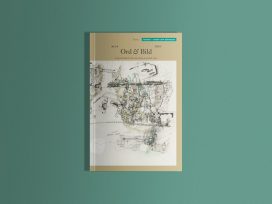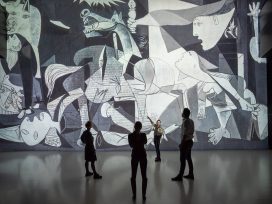Vilnius is like an open book, revealing the history of European art styles from Gothic to Empire. Vilnius is a real treasure to anyone who is inclined to study art history not with the help of books, but from masterpieces of art itself […] Neither enemy attacks, innumerable fires, nor long periods of foreign rule, when our monuments of the Gothic, the Baroque and especially the Renaissance were mercilessly pulled down and damaged, were able to destroy this treasure.
Mikalojus Vorobjovas (1940)
A recent stay in the very heart of the Italian Renaissance, in a city that has managed to maintain its incomparable beauty to this day, inevitably provoked comparisons with my hometown, Vilnius. Well-known for its preserved legacy of Gothic and Baroque architecture, Vilnius also bears less notable and visible traces of the Renaissance, which nevertheless shaped the city’s urban character, especially in the mid-sixteenth century during the reign of Sigismund Augustus – a rich and colourful period in the development of the urban culture of the Grand Duchy of Lithuania. However, over the last two decades, developments in Vilnius’ urban structure have had a strong impact on its cityscape, which has lost many aspects of its former character, the most notable of which was the harmonious balance of nature and architecture that for centuries Vilnius inhabitants were able to boast of.
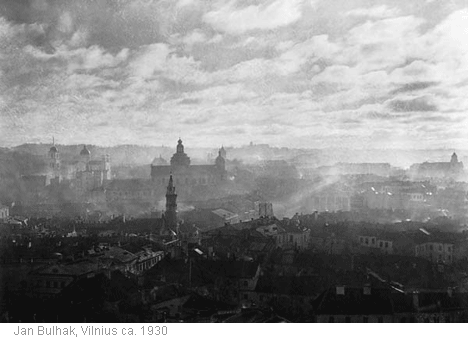 Strange as it might seem, Lithuania’s national resurgence movement in 1990 came into being partly due to the efforts of communities who later turned to the preservation of the urban heritage, which had been badly neglected during the Soviet era. Perhaps less strange is that developments in the last two post-Soviet decades have witnessed the opposite, namely a growing culture of indifference towards the architectural and urban legacy and an alarming ignorance and even neglect of the many problems related to heritage protection. Instead of striving for consensus over the turbulent issues surrounding the preservation of the architectural and urban heritage, politicians, intellectuals and large segments of society became involved in futile polemics over plans to rebuild the palace of Lithuania’s Grand Dukes, destroyed by Russia’s Tsarist regime after the partition of the Polish-Lithuanian Commonwealth. Despite the scepticism of some influential critics, and to a certain extent justified concern over the lack of sufficient iconographic material that the implementation of such a huge and ambitious project would require, political will ensured that construction went ahead. The edifice, later renamed the Ruler’s Palace, was completed in 2010, albeit with finishing touches pending.
Strange as it might seem, Lithuania’s national resurgence movement in 1990 came into being partly due to the efforts of communities who later turned to the preservation of the urban heritage, which had been badly neglected during the Soviet era. Perhaps less strange is that developments in the last two post-Soviet decades have witnessed the opposite, namely a growing culture of indifference towards the architectural and urban legacy and an alarming ignorance and even neglect of the many problems related to heritage protection. Instead of striving for consensus over the turbulent issues surrounding the preservation of the architectural and urban heritage, politicians, intellectuals and large segments of society became involved in futile polemics over plans to rebuild the palace of Lithuania’s Grand Dukes, destroyed by Russia’s Tsarist regime after the partition of the Polish-Lithuanian Commonwealth. Despite the scepticism of some influential critics, and to a certain extent justified concern over the lack of sufficient iconographic material that the implementation of such a huge and ambitious project would require, political will ensured that construction went ahead. The edifice, later renamed the Ruler’s Palace, was completed in 2010, albeit with finishing touches pending.
No matter how artificial this issue of rebuilding was, it overshadowed much more important problems associated with the changing visual character of the city. The generation of politicians that succeeded Lithuania’s post-independence political establishment became increasingly conscious of the role of monetary power and the interests of real estate developers, who became the most important players in designing projects for the capital’s urban development. Further processes of urbanization were rapid, chaotic and largely unbalanced, with the new holders of financial power interested only in the profitability of their own investments and demonstrating an open contempt for public interest. It is not surprising that the urban development of Vilnius was carried out following the old and stale models once suggested by Le Corbusier and his followers, who advocated that “surgery” to be applied to the centre of the contemporary metropolis. This entailed wiping out densely populated city centres along with their Old Quarters and erecting edifices of a new kind in their place. Although such planning models – for example that introduced by the Soviet authorities to Vilnius in late 1950s, which cut the Old Quarters to pieces to make way for a huge highway – were not implemented in full, major damage was done. The Vilnius Old Quarters and their vicinity were treated as a kind of tabula rasa without connection to historical memory. Decaying historical buildings made way for ugly, hastily erected, semi-modernist structures, with the result that Vilnius bears the signs of Soviet aesthetics to this very day.
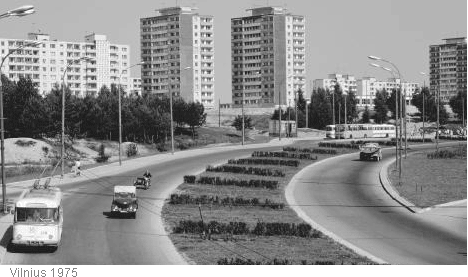 Society’s relationship with its architectural legacy shifted radically during the crucial period of redistribution of wealth in the 1990s, a period that also saw growing political apathy, moral indifference, alienation between social groups and loss of social solidarity, and fewer and fewer barriers against the aggressive penetration of private capital into the Old Quarters and central areas remained. After Gediminas Avenue, the main street in the city centre, had been rehashed as a luxury shopping area, the realtors, developers, nouveaux riches and municipal fathers turned their attention to one of the oldest suburbs of Vilnius, Snipiskes, which, as the city expanded, was more or less incorporated into the neighbourhoods of the central area. The historical structure of Snipiskes, which had remained almost untouched for centuries, was first targeted by urban planners during the Soviet period. The Lietuva hotel (Lithuania) – at that time the city’s tallest building, designed by architects Algimantas Nasvytis and Vytautas Nasvytis, subsequently renamed the Reval Lietuva and a few months ago again renamed the Radisson Blu – became a visual symbol of the “socialist achievements” of Lithuania’s capital and opened up the district for further changes. The Lietuva performed the same ideological function as similar representative edifices in other capitals of the Baltic republics, where hotels for foreign visitors were supposed to glorify the communist regime in visible form as the pinnacle of modern architecture.
Society’s relationship with its architectural legacy shifted radically during the crucial period of redistribution of wealth in the 1990s, a period that also saw growing political apathy, moral indifference, alienation between social groups and loss of social solidarity, and fewer and fewer barriers against the aggressive penetration of private capital into the Old Quarters and central areas remained. After Gediminas Avenue, the main street in the city centre, had been rehashed as a luxury shopping area, the realtors, developers, nouveaux riches and municipal fathers turned their attention to one of the oldest suburbs of Vilnius, Snipiskes, which, as the city expanded, was more or less incorporated into the neighbourhoods of the central area. The historical structure of Snipiskes, which had remained almost untouched for centuries, was first targeted by urban planners during the Soviet period. The Lietuva hotel (Lithuania) – at that time the city’s tallest building, designed by architects Algimantas Nasvytis and Vytautas Nasvytis, subsequently renamed the Reval Lietuva and a few months ago again renamed the Radisson Blu – became a visual symbol of the “socialist achievements” of Lithuania’s capital and opened up the district for further changes. The Lietuva performed the same ideological function as similar representative edifices in other capitals of the Baltic republics, where hotels for foreign visitors were supposed to glorify the communist regime in visible form as the pinnacle of modern architecture.
It should be added, however, that architects themselves played an ambiguous role during the late Soviet period, especially when socialist realism became increasingly exhausted and unable to capture the artistic imagination. While artists in other fields were discouraged from using ultramodern forms or following the various “isms” that the authorities considered suspect, architects were not merely allowed but also encouraged to turn to modern aesthetics. However this freedom to build came with a price: the destruction of historically or symbolically important buildings and even entire old districts. This ideologically engineered “freedom to build” was a huge temptation to several generations of architects and urban planners, who chose to sacrifice professional ethics, historical memory and visual symbols of the past in order to pursue their own endeavours – to leave their individual traces on the rich texture of historical cities, as the signs of modern aesthetics.
Vilnius was no exception. The genius loci or spirit of place was disregarded, neglected and abandoned, standing as it did between the architect and urban planner and his right to build. Aesthetic modernism, so much desired by artists during the decades when any deviation from the code of socialist realism was considered blasphemy to the communist faith, emerged triumphant – however at the expense of visual history and cultural memory. Seduced by the promise to be allowed to implement modernism, leading architects of the period even endorsed the official view in public discussions, arguing for the need to renew Vilnius by simply pulling down morally and aesthetically “worthless” old buildings and erecting modern edifices in their place.
The post-independence resurgence of public interest in heritage conservation was impressive, but, alas, short-lived. Some former activists made their way into politics and gradually shifted their attention to other, more popular and seemingly more promising areas. Others, lacking adequate leadership and facing their own problems in an unstable, changing economic climate, retreated into their own professional fields. Some even succumbed to the idea that having built new national institutions, the time had come to let the professionals do their job. Whatever the reasons were, activism gradually faded away. No wonder the fate of the right bank of the river Neris, the former territory of Snipiskes, was decided as it was. Realtors, planners and municipal leaders blatantly ignored voices of protest that every year sounded weaker and those who considered it their duty to stand up to the urban “surgery” of near-central city districts that still contained certain signs of historical memory were derogatorily labelled “nostalgics”. Instead of reconsidering their development plans, municipal officials and investors opened the way to a drastic remaking of the Vilnius cityscape. The historical structure of Snipiskes was “deconstructed” and the area chosen as the new municipal centre of the capital, despite the fact that the highway running alongside the right bank was becoming a physical obstacle for the development of truly public spaces in the vicinity. This did not seem to bother those who saw a vast potential for expansion of various types of business in the area. The new buildings were designated to attract crowds of people, along with other rapidly growing high-rise buildings in the immediate neighbourhood.
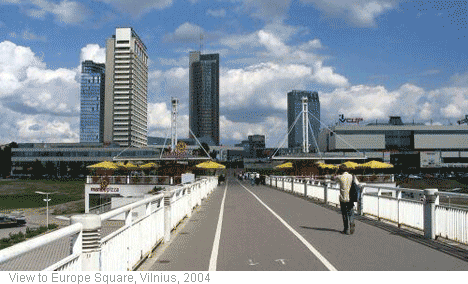 The environs of the notorious “Constitution Avenue” – a large and noisy highway – were chosen as the site for a growing number of commercial and business centres. The process accelerated when the large high-rise “Europe” was erected next to the city council building, the latter far less impressive as an architectural structure, clumsy and ill-shaped. Despite the Europe tower’s “brave new” ambitions (the complex, with its glistening and impenetrable glass plates, was designed to become a new visual trademark for Lithuania’s growing capital), the structure and others like it remain faceless, and in an aesthetic sense even outdated, reminiscent of the modernistic edifices of the 1980s and ’90s and poor allusions to the architecture of the “international style”. The knowledge that western cities are full of equally faceless, inarticulate buildings is hardly a comfort to anyone concerned with the unique historical character of Vilnius, abandoned now in favour of the flow of capital and delusory visions of economic prosperity.
The environs of the notorious “Constitution Avenue” – a large and noisy highway – were chosen as the site for a growing number of commercial and business centres. The process accelerated when the large high-rise “Europe” was erected next to the city council building, the latter far less impressive as an architectural structure, clumsy and ill-shaped. Despite the Europe tower’s “brave new” ambitions (the complex, with its glistening and impenetrable glass plates, was designed to become a new visual trademark for Lithuania’s growing capital), the structure and others like it remain faceless, and in an aesthetic sense even outdated, reminiscent of the modernistic edifices of the 1980s and ’90s and poor allusions to the architecture of the “international style”. The knowledge that western cities are full of equally faceless, inarticulate buildings is hardly a comfort to anyone concerned with the unique historical character of Vilnius, abandoned now in favour of the flow of capital and delusory visions of economic prosperity.
The renowned Vilnius photographer, Jan Bulhak (1876-1950), a true master of light and remarkable essayist who was deeply affected by the beauty of the city, wrote in the mid-1940s that,
Vilnius is so precious, precisely because of the fact that it is not a contemporary city, that it is so close to a village, a garden, a meadow or a pine forest, many of which are all over the country, that it is close to the earth, miraculously concentrated in its motifs in a small hilly, watery and wavy space. It is a manor and a palace, a sanctuary and a monastery, a spacious park and an umbrageous garden, a cluster of luxurious palaces and precious relics, a monument of the greatness of the folk spirit and a witness to its indestructible power. The fascinating landscape of Vilnius merges with great architecture that stresses the merits of the city’s layout and uses them for perfect decorative compositions. The old city decorates itself with three main colours: it sparkles with the whiteness of stone, the redness of brownish roofs, and the luxuriant greenery of verdure.
Mikalojus Vorobjovas, who loved and respected Vilnius no less than Bulhak, praised the unique character of its architecture and natural surroundings in a book published immediately after Lithuania regained its capital in 1940. He noted that,
Nature itself had its own plastic physiognomy, its own architecture. Architecture created by a human being was attuned to nature, enriching and making it more precise. This is how the cultural landscape of Vilnius grew: it contains no artificial forms that would destroy the natural landscape of nature by force, and there is no chaotic penetration of nature into architectural ensembles – everywhere we see a rare harmony and organic unity of elements. It is this that causes the innumerable metamorphoses of Vilnius beauty, always changing and deepening within the atmosphere, depending on the light of the sky.
Looking around at the anonymous, faceless panoramas of the city, full of new building sites, could anybody say the same today?
Many things have changed since Bulhak and Vorobjovas wrote their essays on the aesthetics of the city. Vilnius is no longer reminiscent of a village or even a rural landscape. And yet some of its unique character and peculiar atmosphere is preserved, especially in the Old Quarters, also touching some suburban districts. But these areas increasingly look like inclusions in the new visual structure of the city, dominated by dense, high-rise buildings that clash with the overwhelming symphony of Vilnius’ church towers. Sometimes it seems as if the city is gradually losing its memory, its individuality, its character, and becoming more and more like a cloned global city. The Finnish architect Juhani Pallasma has rightfully reminded us that “We have an innate capacity for remembering and imagining places. Perception, memory and imagination are in constant interaction; the domain of the present fuses into images of memory and fantasy. We keep constructing an immense city of evocation and remembrance, and all the cities we have visited are precincts in this metropolis of the mind.”
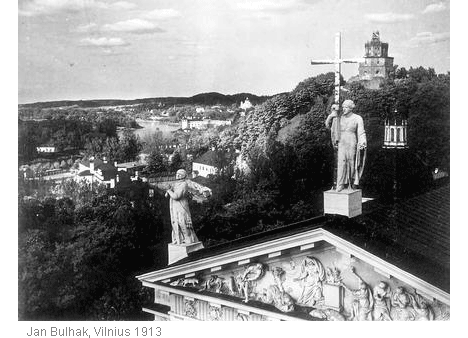 When one crosses Florence’s ponte Vechio to the other side of the river Arno and climbs to the top of the large hill to find a square named after Leonardo da Vinci, the wonderful sight of the city lying below opens to one’s eyes. A closer look at the large panorama of the historical city reveals that the cityscape is not distorted by high-rise buildings; only the impressive cupola of the Santa Maria del Fiore – one of the largest cathedrals – rises over the city, against the background of remote mountains and forests. When I look around the panorama of Vilnius from Tauras Hill, I have to conclude that the cityscape of one of the centres of the eastern European Renaissance has been badly distorted, with barely any hope that this visual destruction will ever come to an end. Behind the complex of the Europe centre and the adjoining council building, a row of new high-rises covered with impenetrable dark glass is growing, speaking its own visual language. This is the language of monotony, anonymity, alienation, contrasting with the elegant towers of the baroque St. Rapolas Church – behind this cluster of cheap glass and concrete, they look sorrowful. Further along, the cityscape is broken by the buildings that rise around the National Gallery – a sound piece of well thought out, minimalist modern architecture that does not attempt to compete with its surroundings. When the eye moves along a bit more, a massive foreign body, the cumbersome dull building of the so-called “Vilnius Gates”, begins to dominate the landscape.
When one crosses Florence’s ponte Vechio to the other side of the river Arno and climbs to the top of the large hill to find a square named after Leonardo da Vinci, the wonderful sight of the city lying below opens to one’s eyes. A closer look at the large panorama of the historical city reveals that the cityscape is not distorted by high-rise buildings; only the impressive cupola of the Santa Maria del Fiore – one of the largest cathedrals – rises over the city, against the background of remote mountains and forests. When I look around the panorama of Vilnius from Tauras Hill, I have to conclude that the cityscape of one of the centres of the eastern European Renaissance has been badly distorted, with barely any hope that this visual destruction will ever come to an end. Behind the complex of the Europe centre and the adjoining council building, a row of new high-rises covered with impenetrable dark glass is growing, speaking its own visual language. This is the language of monotony, anonymity, alienation, contrasting with the elegant towers of the baroque St. Rapolas Church – behind this cluster of cheap glass and concrete, they look sorrowful. Further along, the cityscape is broken by the buildings that rise around the National Gallery – a sound piece of well thought out, minimalist modern architecture that does not attempt to compete with its surroundings. When the eye moves along a bit more, a massive foreign body, the cumbersome dull building of the so-called “Vilnius Gates”, begins to dominate the landscape.
Vorobjovas described Vilnius as an “open book” telling of the history of the evolution of European architectural styles, with a strong educational potential before World War II, when the city had already survived almost two hundred years of Russian imperial colonization and had not yet been subjected to the damage done during the upcoming war and post-war reconstruction. Those two hundred years were accompanied by a lot of damage, the attempts of the colonizers to wipe out collective and cultural memory by destroying the visual symbols of statehood. The remains of the palace of the Grand Dukes was pulled down and a number of Catholic churches were either closed or converted into Orthodox equivalents. Still, the battle was never won against collective memory. Even the Soviet regime, with its contempt for the past during half a century’s rule, proved unable to destroy the cityscape of Vilnius. It is an irony, then, that local finance capital and local realtors are following the same route as their foreign predecessors.
Of course, development projects are based on different reasoning and a different ideology. But the silence of a society in the face of this profit-oriented urban policy, which takes no account of the city both as a visual symbol of history and a collection of memories, indicates that something has happened to our historical consciousness and sense of architectural aesthetics. The future development of this city of memories will be determined by whether those concerned with the future of the Vilnius cityscape can appeal to society at large, awakening its collective consciousness and aesthetic sense.
I conclude my remarks about changes to Vilnius’ urban character and the city’s present physiognomy with an extract from the aforementioned essay by Jan Bulhak, who seems to have been prophetic about the attitudes of people to their city. “It is impossible to remain an indifferent observer in Vilnius. The city draws one closer or repels one. One can understand it or fall in love with it, or reproachfully depart. Not everyone senses the attractive and irresistible power of Vilnius’ fascination, and not everyone understands his or her own attachment.”
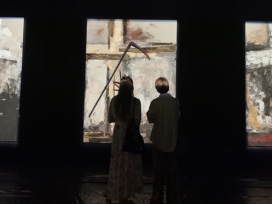
 Strange as it might seem, Lithuania’s national resurgence movement in 1990 came into being partly due to the efforts of communities who later turned to the preservation of the urban heritage, which had been badly neglected during the Soviet era. Perhaps less strange is that developments in the last two post-Soviet decades have witnessed the opposite, namely a growing culture of indifference towards the architectural and urban legacy and an alarming ignorance and even neglect of the many problems related to heritage protection. Instead of striving for consensus over the turbulent issues surrounding the preservation of the architectural and urban heritage, politicians, intellectuals and large segments of society became involved in futile polemics over plans to rebuild the palace of Lithuania’s Grand Dukes, destroyed by Russia’s Tsarist regime after the partition of the Polish-Lithuanian Commonwealth. Despite the scepticism of some influential critics, and to a certain extent justified concern over the lack of sufficient iconographic material that the implementation of such a huge and ambitious project would require, political will ensured that construction went ahead. The edifice, later renamed the Ruler’s Palace, was completed in 2010, albeit with finishing touches pending.
Strange as it might seem, Lithuania’s national resurgence movement in 1990 came into being partly due to the efforts of communities who later turned to the preservation of the urban heritage, which had been badly neglected during the Soviet era. Perhaps less strange is that developments in the last two post-Soviet decades have witnessed the opposite, namely a growing culture of indifference towards the architectural and urban legacy and an alarming ignorance and even neglect of the many problems related to heritage protection. Instead of striving for consensus over the turbulent issues surrounding the preservation of the architectural and urban heritage, politicians, intellectuals and large segments of society became involved in futile polemics over plans to rebuild the palace of Lithuania’s Grand Dukes, destroyed by Russia’s Tsarist regime after the partition of the Polish-Lithuanian Commonwealth. Despite the scepticism of some influential critics, and to a certain extent justified concern over the lack of sufficient iconographic material that the implementation of such a huge and ambitious project would require, political will ensured that construction went ahead. The edifice, later renamed the Ruler’s Palace, was completed in 2010, albeit with finishing touches pending. Society’s relationship with its architectural legacy shifted radically during the crucial period of redistribution of wealth in the 1990s, a period that also saw growing political apathy, moral indifference, alienation between social groups and loss of social solidarity, and fewer and fewer barriers against the aggressive penetration of private capital into the Old Quarters and central areas remained. After Gediminas Avenue, the main street in the city centre, had been rehashed as a luxury shopping area, the realtors, developers, nouveaux riches and municipal fathers turned their attention to one of the oldest suburbs of Vilnius, Snipiskes, which, as the city expanded, was more or less incorporated into the neighbourhoods of the central area. The historical structure of Snipiskes, which had remained almost untouched for centuries, was first targeted by urban planners during the Soviet period. The Lietuva hotel (Lithuania) – at that time the city’s tallest building, designed by architects Algimantas Nasvytis and Vytautas Nasvytis, subsequently renamed the Reval Lietuva and a few months ago again renamed the Radisson Blu – became a visual symbol of the “socialist achievements” of Lithuania’s capital and opened up the district for further changes. The Lietuva performed the same ideological function as similar representative edifices in other capitals of the Baltic republics, where hotels for foreign visitors were supposed to glorify the communist regime in visible form as the pinnacle of modern architecture.
Society’s relationship with its architectural legacy shifted radically during the crucial period of redistribution of wealth in the 1990s, a period that also saw growing political apathy, moral indifference, alienation between social groups and loss of social solidarity, and fewer and fewer barriers against the aggressive penetration of private capital into the Old Quarters and central areas remained. After Gediminas Avenue, the main street in the city centre, had been rehashed as a luxury shopping area, the realtors, developers, nouveaux riches and municipal fathers turned their attention to one of the oldest suburbs of Vilnius, Snipiskes, which, as the city expanded, was more or less incorporated into the neighbourhoods of the central area. The historical structure of Snipiskes, which had remained almost untouched for centuries, was first targeted by urban planners during the Soviet period. The Lietuva hotel (Lithuania) – at that time the city’s tallest building, designed by architects Algimantas Nasvytis and Vytautas Nasvytis, subsequently renamed the Reval Lietuva and a few months ago again renamed the Radisson Blu – became a visual symbol of the “socialist achievements” of Lithuania’s capital and opened up the district for further changes. The Lietuva performed the same ideological function as similar representative edifices in other capitals of the Baltic republics, where hotels for foreign visitors were supposed to glorify the communist regime in visible form as the pinnacle of modern architecture. The environs of the notorious “Constitution Avenue” – a large and noisy highway – were chosen as the site for a growing number of commercial and business centres. The process accelerated when the large high-rise “Europe” was erected next to the city council building, the latter far less impressive as an architectural structure, clumsy and ill-shaped. Despite the Europe tower’s “brave new” ambitions (the complex, with its glistening and impenetrable glass plates, was designed to become a new visual trademark for Lithuania’s growing capital), the structure and others like it remain faceless, and in an aesthetic sense even outdated, reminiscent of the modernistic edifices of the 1980s and ’90s and poor allusions to the architecture of the “international style”. The knowledge that western cities are full of equally faceless, inarticulate buildings is hardly a comfort to anyone concerned with the unique historical character of Vilnius, abandoned now in favour of the flow of capital and delusory visions of economic prosperity.
The environs of the notorious “Constitution Avenue” – a large and noisy highway – were chosen as the site for a growing number of commercial and business centres. The process accelerated when the large high-rise “Europe” was erected next to the city council building, the latter far less impressive as an architectural structure, clumsy and ill-shaped. Despite the Europe tower’s “brave new” ambitions (the complex, with its glistening and impenetrable glass plates, was designed to become a new visual trademark for Lithuania’s growing capital), the structure and others like it remain faceless, and in an aesthetic sense even outdated, reminiscent of the modernistic edifices of the 1980s and ’90s and poor allusions to the architecture of the “international style”. The knowledge that western cities are full of equally faceless, inarticulate buildings is hardly a comfort to anyone concerned with the unique historical character of Vilnius, abandoned now in favour of the flow of capital and delusory visions of economic prosperity. When one crosses Florence’s ponte Vechio to the other side of the river Arno and climbs to the top of the large hill to find a square named after Leonardo da Vinci, the wonderful sight of the city lying below opens to one’s eyes. A closer look at the large panorama of the historical city reveals that the cityscape is not distorted by high-rise buildings; only the impressive cupola of the Santa Maria del Fiore – one of the largest cathedrals – rises over the city, against the background of remote mountains and forests. When I look around the panorama of Vilnius from Tauras Hill, I have to conclude that the cityscape of one of the centres of the eastern European Renaissance has been badly distorted, with barely any hope that this visual destruction will ever come to an end. Behind the complex of the Europe centre and the adjoining council building, a row of new high-rises covered with impenetrable dark glass is growing, speaking its own visual language. This is the language of monotony, anonymity, alienation, contrasting with the elegant towers of the baroque St. Rapolas Church – behind this cluster of cheap glass and concrete, they look sorrowful. Further along, the cityscape is broken by the buildings that rise around the National Gallery – a sound piece of well thought out, minimalist modern architecture that does not attempt to compete with its surroundings. When the eye moves along a bit more, a massive foreign body, the cumbersome dull building of the so-called “Vilnius Gates”, begins to dominate the landscape.
When one crosses Florence’s ponte Vechio to the other side of the river Arno and climbs to the top of the large hill to find a square named after Leonardo da Vinci, the wonderful sight of the city lying below opens to one’s eyes. A closer look at the large panorama of the historical city reveals that the cityscape is not distorted by high-rise buildings; only the impressive cupola of the Santa Maria del Fiore – one of the largest cathedrals – rises over the city, against the background of remote mountains and forests. When I look around the panorama of Vilnius from Tauras Hill, I have to conclude that the cityscape of one of the centres of the eastern European Renaissance has been badly distorted, with barely any hope that this visual destruction will ever come to an end. Behind the complex of the Europe centre and the adjoining council building, a row of new high-rises covered with impenetrable dark glass is growing, speaking its own visual language. This is the language of monotony, anonymity, alienation, contrasting with the elegant towers of the baroque St. Rapolas Church – behind this cluster of cheap glass and concrete, they look sorrowful. Further along, the cityscape is broken by the buildings that rise around the National Gallery – a sound piece of well thought out, minimalist modern architecture that does not attempt to compete with its surroundings. When the eye moves along a bit more, a massive foreign body, the cumbersome dull building of the so-called “Vilnius Gates”, begins to dominate the landscape.

